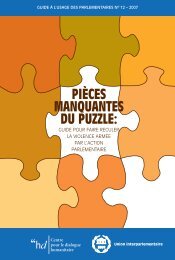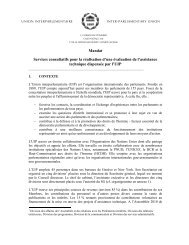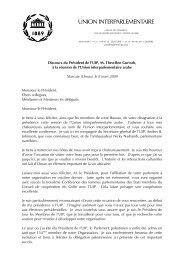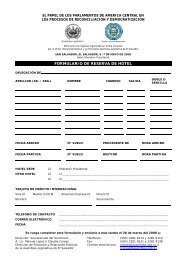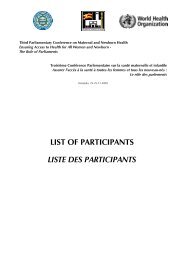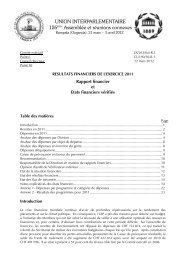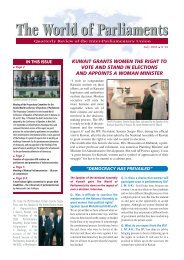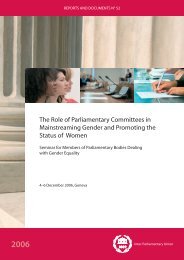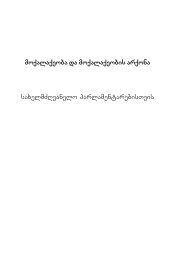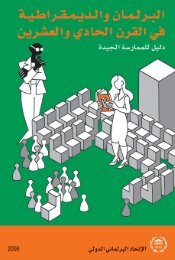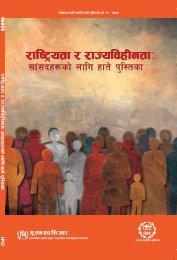MISSING PIECES - Inter-Parliamentary Union
MISSING PIECES - Inter-Parliamentary Union
MISSING PIECES - Inter-Parliamentary Union
You also want an ePaper? Increase the reach of your titles
YUMPU automatically turns print PDFs into web optimized ePapers that Google loves.
THEME 5<br />
agencies. 5 The DDR component was completed in June 2006, with the<br />
programme managers – UNDP and UNAMA – estimating that 25% of the<br />
ex-combatants have found a long-term and sustainable activity. In order<br />
to ensure sustainability of the overall DDR effort, ANBP and UNDP, in<br />
agreement with the Afghan Government, are looking at a Reintegration<br />
Support Project (RSP) to last until December 2007 and follow up DDR.<br />
Collective incentives benefiting a whole group or community are also<br />
increasingly used. The risk of commercialising guns is lower when offering<br />
collective benefits. After violent conflict, it may also avoid the impression<br />
that ex-combatants are rewarded for their participation and behaviour during<br />
the war and reduce the risk of resentment by the local community. The<br />
most frequently used collective benefits have been those that either contribute<br />
to social and economic welfare, such as schools or roads in so-called<br />
‘weapons for development’ schemes, or those that can reduce public insecurity,<br />
for instance by providing equipment for the local police.<br />
The ‘weapons for development’ approach underscores the acknowledgement<br />
on the part of implementing agencies of the links between security<br />
on the one hand and socio-economic development on the other.<br />
When providing collective benefits, one of the challenges is to determine<br />
the type and number of guns that must be collected in order for the<br />
community to achieve the reward. This can be problematic because it<br />
implies knowing, to some extent, the number of guns in circulation before<br />
the project gets underway and the relative insecurity associated with different<br />
weapons. <strong>Inter</strong>estingly, a survey conducted in one Cambodian district<br />
where a weapons for development programme was carried out showed<br />
that for many people, improved community security was considered a<br />
sufficient reward and in fact valued more than the development projects<br />
they ‘received’. 6<br />
3. The inclusion of ammunition<br />
The issue of small arms control cannot be adequately addressed without<br />
a specific focus on ammunition (see Box 8 for more detail). The absence<br />
of matching ammunition to weapon type renders a gun non-functional.<br />
Taking ammunition out of circulation will have a more immediate impact<br />
on reducing gun violence than collecting and destroying weapons. Anecdotal<br />
evidence suggests that ammunition ‘shortages’ are a real phenomenon<br />
and could perhaps be induced with international and co-ordinated efforts.<br />
Enhanced efforts to collect and destroy ammunition should be undertaken<br />
as part of a more comprehensive strategy to control its availability.<br />
99



